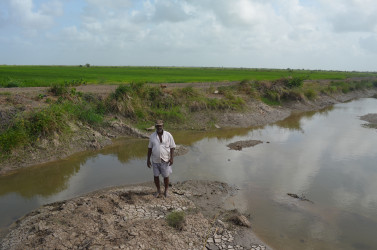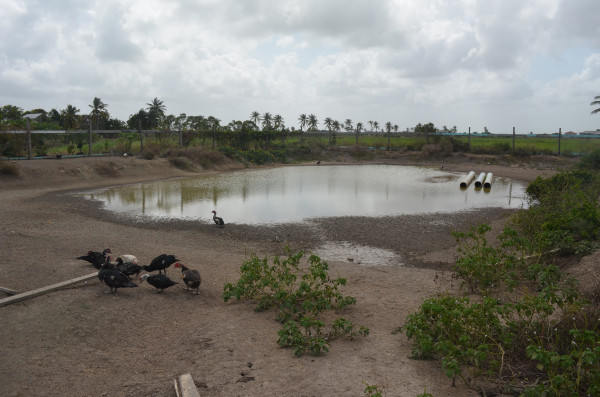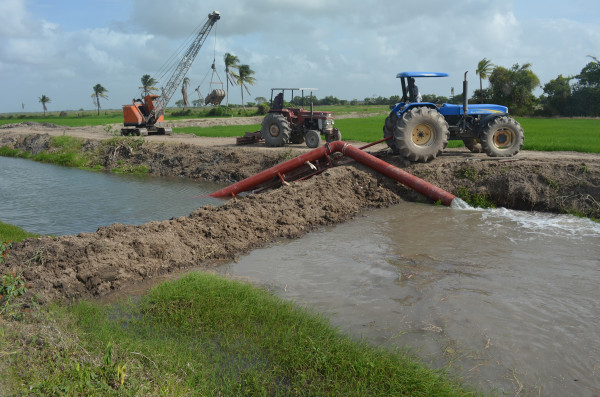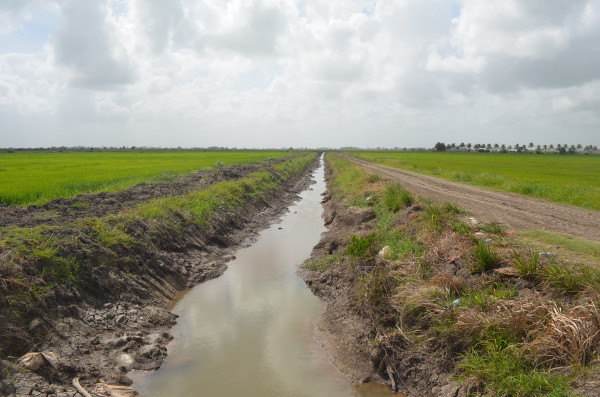Farmers in the Mahaica and Mahaicony areas are preparing for enormous losses as they desperately seek to preserve limited water stores, which they say are being selfishly siphoned off.

“We got to sleep and watchman ’cause people ah pump the water in the night. Only now them man step in and they got to ease. They got to let the water full the system back now,” rice farmer Susankar (only name given) told Stabroek News yesterday.
As dry weather persists throughout the country, some farmers in the areas had resorted to blocking several canals in order to secure water for their own lands. As a result, the Mahaica-Mahaicony-Abary Agricultural Development Authority (MMA/ADA) had started to monitor and regulate the use of water.
However, despite multiple warnings, the farmers closer the source of the water are still pumping water for their own use and ignoring the other farmers, who are dreading enormous losses.
Susankar explained that in a bid to stop the other farmers from pumping water from the already empty canals, a team of farmers would have to patrol the Mahaica farmlands. “At the back here, about 40 of us are here until day clean this morning. This place does be busier than Sheriff Street ’cause [we] ain’t want nobody pump water and leave the well dry,” he said, while noting that they found someone pumping water during the night and they stopped him.
Susankar said the only way the farmers won’t lose thousands of acres of rice is it rains and if the farmers start to cooperate with each another and share the already limited water.
“But, of course, nobody ain’t want to do that because everybody think that they crop is more important. Even the ones who just throw and got young rice think that they own more important than ours that ready to bear and just need one more water to harvest,” he said, while emphasising that the MMA/ADA and the National Drainage and Irrigation Authority (NDIA) need to put their feet down.
“Look this situation is beyond a lot of people control and everyone needs to understand that. I don’t want anyone do anything to anyone, I just want to get water so I can at least finish half of my crops,” he stated.
He stated that out of the 300 acres that he planted, he knows that he would not be able to save the entire thing and he is aiming right now at harvesting around 150 acres. He said that in the case that the farmers are not able to save the majority of their crops, the price of a bag of paddy should be increased. “Last year, we were paid $1,900 a bag of paddy and is only one man give we $2,500 for a bag but that ain’t gonna work this time. With all the diesel we have to use to pump water and other expenses, it won’t make sense if they give we the same price,” he reasoned.
Susankar explained that if the situation remains the same and farmers that are in their last stage are not provided with the water they need to harvest their crops, they will not be able to start another cycle as most of them are in debt and would not be able to finance another crop cycle. “Most, if not all farmers, work on a credit system. We does take the fertiliser from the millers and when we harvest and take it to them they does take out back the money and that’s how it works,” he said, adding that if they are unable to harvest this time around they would be placed in a situation where they are too much in debt.
Gov’t help
One of the farmers stated that when the dry season had hit them hard in 2010 and the farmers had suffered a major loss, the then PPP/C government had given them $10,000 per acre and had also supplied them with bags of paddy so they could start another crop cycle. “It helped us then and how the situation is looking now it seems as if it’s going to be just like that or even worse and we hope that the new government can do something like that again,” he said. He noted too that the authorities could have prevented the El Nino weather phenomenon from having such an impact if they had heeded the warnings and started the pumping of the water that they currently have ongoing. “If we ain’t getting flood out when the conservancy open, then we getting dry out when it ain’t got water. If never ending for us and we always suffering,” he added.
Harry Prashad, a rice farmer for over 45 years said that this is the worst dry season he has faced since he has been farming rice. “Somebody open the koker and all the water blow in the canal and now about 70 acres of my crop are destroyed,” he said.
According to Prashad, he has already lost more than $6 million and he is currently relying on the rice farms he has in Berbice. “That’s what me depending on. I know the MMA trying to regulate and help the people but them farmers are not listening,” he said.
Another farmer, Annant, is set to lose about 150 acres of rice if he doesn’t receive the amount of water he needs in the coming week. He said that his crops are at a stage where they are ready to bear. “All in the same stage and some even starting to burn out because of the lack of water. But what me supposed to do? They ain’t got water,” he lamented.
While the lack of water is a major problem, the farmers are also faced with a salt water intrusion that can possibly destroy their crops and damage their lands. “Because of the lack of water, the salt water is coming down and we can’t let that get onto the lands at all because it’ll cause more damage than the lack of water,” said a farmer, who was valiantly trying to pump the salt water out of the canal in order to make space for the “sweet water.”
“It seems like I am the only one trying here too. Nobody ain’t want to cooperate and all them other farmers passing me and seeing me alone pumping the water but I bet you when it gone all of them gon’ want to come pump the sweet water,” he added.
While rice farmers are suffering the most, livestock farmers are also anxious. Prashad, who has about 120 ducks, is set to lose them all if their pond, which has almost dried out, doesn’t fill in the coming week.
“Is not them [rice farmers] alone, we feeling it too cause they ain’t got grass for the cows to eat or water for them to drink. When they go down in the canal to drink, they getting stick and all kinds of things,” one of the livestock farmers said, while noting that so far he has lost two calves. Other cattle farmers are left to leave the animals outside for longer periods because of the lack of food. “We have to leave them out to get enough grass and that means they in the sun more. When they got grass, them cow them does be in the shade now they in the sun all the time looking for food and they ain’t getting water either,” he pointed out.
A source at the MMA-ADA had told Stabroek News that while the Abary and Berbice blocks still have enough water to last through the current crop cycle, the Mahaicony and Mahaica blocks are seeing a rise in water levels since the farmers have started cooperating. “There is a slight build up at Mahaicony and Mahaica that is currently ongoing since the farmers are starting to cooperate and our staff are regulating the water 24/7,” he had said, while noting that due to pumping from the Pine Ground, Mora Point and Kuliserabo stations, the water levels are slowly increasing. “The pumps have been working for about two weeks but because everyone [was] pumping then the water kept going down fast,” he had further said, while noting that the water is slowly rising following the MMA/ADA’s intervention to monitor and regulate the use of water.
The Ministry of Agriculture had announced that the NDIA was working in conjunction with the MMA-ADA to address the situation and urged the farmers to refrain from tampering with the drainage systems as they would be prosecuted if they were caught in the act.










